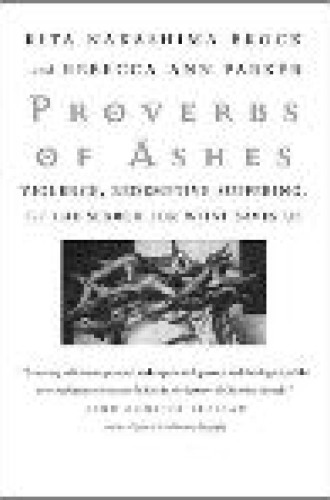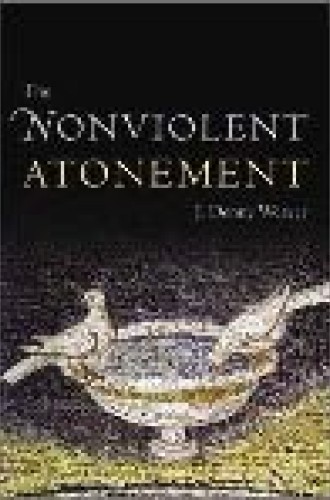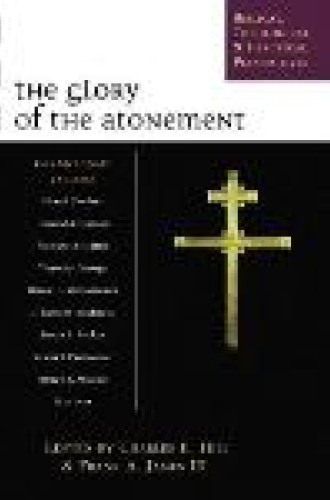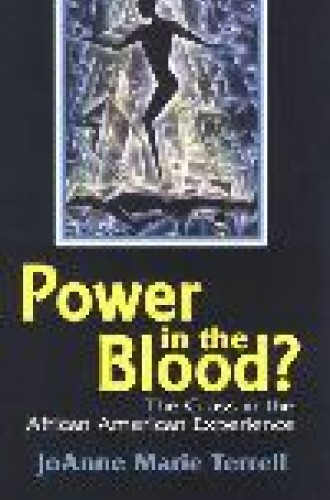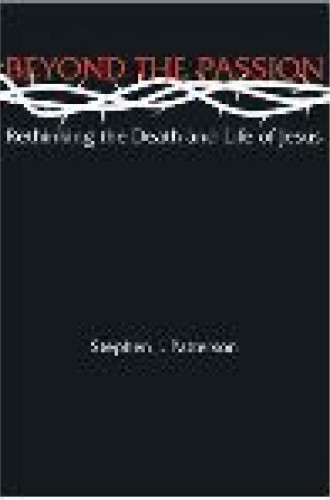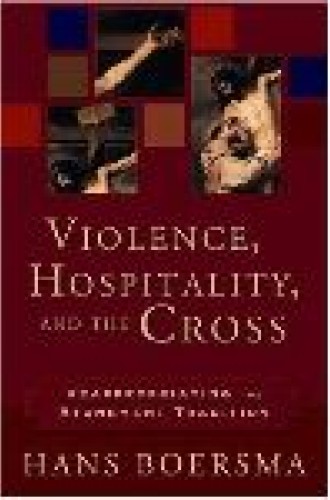Cross purposes
Is the story of Jesus mainly about his death and a life that leads to it, or is the story of Jesus mainly about his life and a death that flows from it? On one view, it hardly matters: these are just two ways of looking at the same thing. On a more combative view, the difference is as great as night and day. Does the cross belong on the sleeves (and hearts) of Christians, as the glorious core of their faith, or does it belong in the repair shop, in need of drastic repairs, the primary Christian embarrassment for believers and an offense to outsiders?
The disagreement is not over Jesus’ death as a fact. Both sides largely agree about the reality and circumstances of the crucifixion and, for that matter, of the resurrection. At least, the disagreement within one side on these issues is as great as the disagreement between the sides.
No, the conflict revolves around a theology of the cross, a theology that says Jesus’ death is the supreme saving act, and that the equation of guilt, punishment and grace worked out through the execution of the innocent, divine victim in place of a rightly condemned humanity provides the essential sum of Christianity itself.
This theology is composed of many elements in scripture and tradition—references to Jesus’ death as a sacrifice, ideas of redemptive suffering, and a deep tradition of eucharistic remembrance that Jesus died “for us.” These elements appear in all branches and eras of Christian tradition. But the organization of them into a complete substitutionary view of the atonement is much less universal. Such a view has never been prominent in the Eastern Christian church, and it was not the dominant view in the Western church for the first half of its history.
Many think the rise of atonement theology represented a terrible wrong turn, plunging Christian spirituality into a toxic brew of idealized masochism, authorized violence and social domination. In Proverbs of Ashes, two feminist theologians make this case. They make it not with heated rhetoric but through a narrative intertwining their searing personal histories of abuse, depression, ministry and loss with reflections on where Christian beliefs have abetted the destructive forces in their lives and where they have been part of the healing.
Unlike many first-person approaches to controversial issues, the book’s net effect is neither bitter nor dogmatic. The authors’ honesty and vulnerability invite a genuine dialogue. Anyone who thinks there isn’t a problem should start here.
If Rita Nakashima Brock and Rebecca Ann Parker make a case against atonement in experience, Denny Weaver complements it with a case drawn from history. The Nonviolent Atonement is a full-scale attack on St. Anselm’s and others’ substitution theologies of the cross, and it also spells out an alternative, which he calls “narrative Christus Victor.” The saving work of Jesus is his struggle against and victory over the structural evil powers of this world. Weaver adds “narrative” to the phrase Christus Victor because some might focus this battle entirely on Jesus’ death. Weaver’s point is that the saving work is one continuous story, in which the cross is just one moment.
A Mennonite, Weaver associates the elevation of the cross with the fall of the church. The rise of a theology of God’s redemptive use of punishment goes hand in hand with a church that learns to endorse the military force of a Christian state. His book also includes an impressive review of recent treatments of this topic by feminist, womanist and African-American theologians, perspectives that he weaves effectively into his argument.
If these two books call for a root-and-branch excision of atonement, The Glory of the Atonement is a collection whose writers bring a “don’t throw out the baby with the bathwater” caution. The former writers see the idea of atonement itself as an error. The latter collection see destructive effects sometimes flowing from faulty theological expressions. On the doctrine itself, the introduction quotes Emil Brunner: it is “the Christian religion itself; it is the main point; it is not something alongside of the center; it is the substance and kernel, not the husk.”
The essays are careful studies of scriptural texts that bear on the topic and of major theologians who have developed it. The book is a handy way to engage the truly monumental tradition of substitutionary interpretation and a summary of the arguments for its prominence.
Robert Sherman and JoAnne Marie Terrell work carefully in the tangled ground between these two parties. Since criticism of atonement is often made in the name of the oppressed or marginalized, the African-American experience is of particular importance. In Power in the Blood? Terrell patiently works through the place of the cross in the history and faith of the black church.
This is an ambiguous story, for the theology of atonement was at times deployed with an intent or effect of inducing complacency among those in bondage. But at the same time slaves and their descendents passionately appropriated the story of the unjustly crucified Jesus as their story too. Many of them found in it the power they needed to survive, a power that “affirmed their innocence, refuted the claims of white supremacists, sanctified their own suffering and situated them within the cosmic drama as victims-becoming-victors.”
If Terrell demonstrates that reality often gives a more complicated verdict than “guilty” or “not guilty” regarding the doctrine of the atonement, Sherman reminds us that from a systematic theological perspective, the doctrine was never meant to stand alone. King, Priest, and Prophet reviews the substitutionary approach to Christ’s death along with other major historical options—those that see it as an exemplary illustration of God’s love, those that see it as a victory over evil powers. He concludes that the faults of any one are addressed when they are coordinated together, and an explicitly trinitarian theology is the framework necessary to do this. Theology, liturgy or devotion narrowed to the resources or images from only one of these approaches will necessarily be distorted. Someone who wants a map of the entire landscape would do well to start with Sherman’s book and then go on to some of the others listed.
Stepping onto this well-muddied field of discussion is Stephen Patterson. Beyond the Passion: Rethinking the Death and Life of Jesus definitely belongs to the atonement-was-a-wrong-turn school. His very thoughtful and readable book contends that the real meaning of Jesus’ death, for the first Christians and for us, is the challenge to live as he lived and taught. He would be happy to summarize that teaching and example in terms of Weaver’s “victory over the powers”—the powers being understood very concretely as the Roman Empire, with the oppressive social-religious conventions of that time, and the American Empire, with the oppressive social-religious conventions of our time. Jesus pointed a way to an alternative empire of God and demonstrated in his own life that you could live as though you already belonged to it. His death showed that you could follow that path through, without retreat, to the very end. Knowing Jesus had done it, his disciples had hope that they could too.
Patterson is a New Testament scholar. Though the touch of that learning is pleasantly light, he scatters many historical insights along the way. Using three categories (victim, martyr and sacrifice), he marshals early Christian materials under each heading to support his argument, which points followers of Jesus “back to his life—to his words, his deeds and his fate—as a life to be embraced as the life, and a fate to call one’s own.”
To take just one example, Patterson deftly interprets the treatment of sacrifice in the letter to the Hebrews in the context of practices in the surrounding Roman world. He demonstrates in the process how Christians’ affirmation of Christ’s death as the sole sacrifice amounted to a powerful political statement, since in that culture sacrifice was understood as the very glue that held together the existing social structures. To attach such a view to Jesus’ death was really to confirm the revolutionary practice of Jesus’ life.
The book’s theological reflection on Christ’s death is set in the context of the John Dominic Crossan and Marcus Borg strand of New Testament scholarship (on which Patterson plays his own variations). If we ask which life of Jesus the death points back toward, it is the life of one who practices open table fellowship, who has a message of divine favor for the least and the outcast, and who gives the Romans and their puppets good reason to suspect that a peasant-worker awakening is under way.
Patterson points out that belief in resurrection or translation into heaven was not uncommon in the hellenistic world, but the expectation was associated with emperors and the like. Jesus was a nobody, a visionary martyred for a cause. His followers believed in him and his cause. Since his cause was just, they believed a righteous God ought to raise him if he fell to his enemies. He deserved to be on the same plane with the Caesars (or higher). The scandalous thing about claiming resurrection for him was not that such a thing should happen at all, but that it should happen to this nobodies’ somebody. The point was not that sins had been removed or that a dead person was alive: it was that Jesus’ message was right. “This is why, when at last he was killed, they proclaimed his resurrection. They could have done this on the day he died, and probably did.”
I don’t know too many New Testament scholars who think the disciples probably proclaimed the resurrection the day Jesus died. One of Patterson’s prime objections to traditional doctrine is that it does not fit with the historical facts as he reconstructs them. But at points his theological proposal seems linked to historical assumptions that are as problematic as any made by traditional theories.
Though most of the book coheres smoothly with the other antiatonement works noted, Patterson diverges somewhat at the point of Jesus as model. He unequivocally affirms that Christians should embrace Jesus’ fate—his life and suffering death—as their own. Some critics regard this response as one of the most destructive features of traditional theology, especially as an ideal propounded to the weak, and take special pains not to commend imitation of Jesus’ fate. In some ways the substitutionary teaching, that Christ has done once and for all what no other need or can do, is less liable to this application than a teaching that puts its weight on Jesus’ example for us.
In contemporary discussions of the cross, the topic of violence is never far from the surface. Patterson is clear that Jesus’ death is the work of an evil empire and that God had nothing to do with it. One of the most consistent criticisms of atonement theologies is that they portray a God who endorses violence (affirms penal suffering as the remedy for guilt) and practices it (God orchestrates Jesus’ killers in the grand salvation plan). Such criticisms typically take it as self-evident that we need to entirely dissociate God from violence. In Violence, Hospitality and the Cross, Hans Boersma boldly questions that assumption.
Boersma views Jesus’ work as an act of recapitulation, in which the incarnate God retraces the path by which our humanity has gone astray and heals and transforms it from the inside. Boersma covers the Christian tradition with the same easy erudition that Patterson covers the biblical context. With the recapitulation theme he draws together the prophetic, priestly and royal dimensions of Jesus’ work in a unity much like that outlined in Sherman’s book. Traditional atonement doctrine is very much a part of that unity for Boersma.
He says that the vision of unrestricted hospitality and total nonviolence is appropriate to our eschatological hope, but is misleading if applied to the historical struggle against sin. The dogmatic rejection of a God in any way soiled by contact with violence is akin to the complaint of a drowning man who insists his rescuer should not get wet.
What is most helpful about Boersma’s book is his insistence that we think carefully about these categories. Any use of force or coercion (physical or nonphysical) that brings some harm or injury to another is violence, he suggests. He notes that Weaver, for one, insists that many nonphysical acts of resistance that undeniably bring harm (like economic sanctions or strikes) do not count as violence, while other nonphysical acts that might bring harm (tax policies or cuts in education funding) can be violence. Conversely, some physical coercion that may harm someone (pulling to the ground a child who was about to run in front of a car or forcibly intervening in an attempted suicide) is not counted as violence. Weaver, and others, are particularly concerned to emphasize that nonviolence does not rule out effective and active forms of resistance to evil.
Does this simply amount to excluding anything on our personal list of “good force” from violence by definition? Would it be more honest to admit that there is such a thing as redemptive violence, employed at times by faithful people and even by a loving God?
Boersma frames this issue in terms of hospitality. God’s nature and eschatological design both point toward universal hospitality. Indeed, the incarnation is an act of such hospitality, in which God invites and receives all people and their broken nature into the divine life itself. But under the conditions of time and sin, hospitality has an intrinsic dimension of exclusion. It is conditional hospitality.
Is the God of the cross the same as the father of the prodigal son? Boersma says yes—but we have to imagine the shape of hospitality when it goes beyond receiving the already repentant returning child with open arms. What if God had gone to the far country to find the unrepentant child rather than waiting at home? What kind of hospitality would that be?
At the risk of skewing Boersma’s very dense discussion, I would explain it this way: God’s arms are still open, but much of our current way of life, much that we may even think of as part of ourselves, does not fit within those arms. God loves us as we are, but invites us to be different. At the very least this is the coercion of the parent who says to a grown child: Our house is yours but your drugs and drug-dealing are not welcome here. If you cannot separate yourself from them, you will be separating yourself from us and cannot stay. Such punishment is restorative. It serves the purpose of a fuller hospitality. Not only God’s justice but also God’s mercy requires it. God’s coercion, if we may put it that way, is God’s refusal to be hospitable to our sin.
Yet the unfathomable further step is that if this conditional hospitality results in punishment or exile, God then acts to share that same condition with the child. The cross is not just a concrete illustration of this constant truth. It is also a moment in the historical covenant of God’s relationship with humanity, a moment when judgment is actually rendered on evil, and the pain of that judgment (which includes a separation from God, a nonhospitality) is borne by the incarnate Word.
In a final section of the book, Boersma draws out the implications of his view for the Christian life. He rejects an absolutist form of nonviolence, and argues that short of the eschatological fulfillment Christians themselves must practice a conditional hospitality. This requires a prophetic witness against injustice but also a sober one, which can rule out neither the use of violence nor the expectation of a suffering like that of Jesus.
Violence, Hospitality, and the Cross offers a fresh and independent perspective. But the work is somewhat marred by a rather elliptical pattern of argument. This gives a good deal of texture, but it often leaves the reader groping for clarity on major points. Nowhere is there a full and clear answer given to the problem implicit in the entire project: how exactly is God exercising violence in the crucifixion of Jesus and how (and why) is God exercising it against Jesus? The argument is highly suggestive, but a good deal of that suggestion seems to evaporate when the book’s cover is closed, for want of a firm summary to contain it.
Patterson and Boersma have written two very different but very fine books, the one plainly hoping to replace atonement and the other trying to retrieve it. In that sense they represent the two broad parties to the discussion. Each has its special setting—Patterson in the Crossan-Borg vein of New Testament criticism, Boersma in the broad tradition of Reformed theology. Beyond the Passion is the easier of the two to pick up cold, while Violence is more demanding of the reader. If one wants to be of two minds about the cross, one could do with both.


